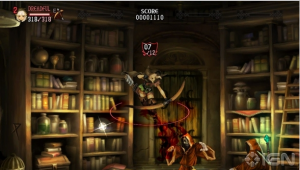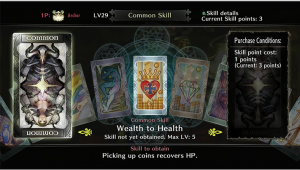After months of debates and criticisms, Dragon’s Crown: the latest game from Vanillaware has finally made it to the US, while featuring a stylized world of over exaggerated characters. While many people tend to focus on debating the art style it can be easy to forget that Dragon’s Crown’s gameplay does a lot for the beat-em-up genre… but not much for ARPGS.
Sexy vs. Sexualized:
Having made two posts about Dragon’s Crown’s art style in the past, it’s time to give me overall judgment on that topic.
Dragon’s Crown’s story and world are your standard fantasy trope: Ancient treasures abound and adventurers risk life and limb for them. The part that has people up in arms is the depictions of the women. The art style is all about overly exaggerated character designs with men who don’t have chests as much as walls of abs, while women take the hourglass shape to new definitions.
Much has been written and debated about Dragons Crown’s art style — some say that it is a tribute to old school fantasy while others feel that it is using that as a justification for sexist designs. What makes it difficult to lay down a ruling is that Dragons Crown is overtly sexualized for both genders with only the wizard and elf main characters as the most normal looking.
However, there are far more examples of women in sexualized or a suggestive pose than the men. Once again, people can make justifications both for and against such depictions due to the history of the genre. In my opinion, Dragon’s Crown is a game that sexualizes both genders to their extremes, but there was a conscious decision to lean more towards women than it does men in terms of sexualized scenes.
Whether or not that is a deal breaker or part of the charm is something that I’m not in the position to rule on and I’ll leave it to you to decide.
Since Game-Wisdom is about examining game design, I can tell you that the art style did not have any impact one way or the other on my analysis of the game.
It is a shame that for the people on either extreme denouncing or praising the art style fail to talk about the gameplay. As Dragon’s Crown is the strongest showing from Vanillaware yet on that front.
Dungeon Punching:
Dragon’s Crown’s gameplay is a cross between a traditional beat-em-up and an ARPG. The five characters (I’m counting the sorceress and wizard as one as they play largely the same) are different from each other both in how they handle during combat and improving them.
The developers have also used that to segment the difficulty with the melee characters: Amazon, Dwarf and Fighter considered easier than the ranged/support of Elf, Sorceress and Wizard. The flow of the game has you watching cut-scenes in town to get your quest and then picking one of 9 levels to fight through.
The ARPG side of the game comes in how you’ll improve your chosen character. In every level there are treasure chests both hidden and on the main path for you to open with your traveling thief. When you open a chest you’ll receive a random piece of treasure with a rank but you won’t know exactly what it is just yet.
After you either beat a level or retreat, you’ll be able to appraise any treasure you found for gold. Just like a normal ARPG you’ll have to decide if flat damage or defense is better than having buffs on your gear.
The best way to acquire loot and gold is to see how many levels you can go through without returning to town to repair and restock. Each level you complete will raise the rewards on the next.
Completing levels and quests will earn you experience points that on level up will award that character a skill point. Skill points can be turned in at the adventurer’s guild and applied to two skill trees: a class specific one and a general one. This is where you’ll unlock additional moves, class specific items and generally make your character better.
One thing about Dragon’s Crown is that it does play its cards close to its vest as the developers continued to unlock content as you play including an additional harder path for each level.

All equipment in the game is randomized with the best loot coming from playing as many levels in a row as possible.
Unusually, the developers made the choice to lock online play until you complete the first set of levels.
But as you explore levels, you’ll find bones that can be taken back to town to be resurrected and used as AI companions.
The AI is decent, but lacks the common sense to avoid obstacles and when a boss uses its big bad attack.
On one hand, spreading out content is a great way to keep a game fresh, but it takes awhile before the game gets going and that leads us to my problems.
A Bump in the Middle of the Road:
Dragon’s Crown as mentioned sits between an ARPG and a beat-em-up in terms of design. However, games based on multiple genres tend to not give both genres equal billing and in Dragon’s Crown’s case it was the ARPG side.
One of the simple joys of the ARPG genre is seeing your character become more powerful visually with the gear they find. Due to VanillaWare’s hand drawn art-style that would have been impossible. Instead the only visual cue that is different comes from the weapons that you find and the color you pick when creating a new character.
While character progression and leveling up were a part of the ARPG design, they were kept very basic as the bulk of the design was focused on the beat-em-up side of things. I would have liked to see more in terms of character abilities and just generally more ways to differentiate my character from everyone else.
The loot system was a great foundational system, but it lacks the variety and depth that we see in some of the better ARPGs like Diablo 2 or Drox Operative. Outside of magic staves, the weapons themselves function the same way with exception to their attributes. That means, a level one sword for the fighter, will behave the same exact way as a level 35 sword.
The attribute system also falls into the same problem that we saw with Diablo 3’s system: Too many insignificant choices. There is a huge variety of modifications that can be attached, but only a handful that are both noticeable and useful for characters. For instance, improving the INT stat only helps spell casters out and if it is on gear for any other class then it is useless.
Buffs like ” +5% chance for ice retribution” or “+10% damage to undead” are so small that you can’t really count on them compared to just flat damage and the same can be said in regards to defensive items.
I was really hoping for more ARPG staples like rare attributes or even something like set items. While enemies do grow in strength there are no named enemies or modified enemies that show up.
Judging from the gameplay, VanillaWare was focused on making a beat-em-up above all else with the ARPG elements more of a window dressing. While I can’t fault them for that, to go halfway with unique characters and an engaging loot system and then stop, doesn’t feel right.

To its credit, every class in the game handles differently. I just wish the loot showed as much diversity.
Going back to my Diablo 3 comment, another issue taken from that game would have to be game padding.
Like in Diablo 3, the good stuff like rarer items and more challenging enemies don’t appear until later difficulty levels. This forced players to perform “busy work” before they started to get into the real game.
Dragon’s Crown is the same way with stronger enemies, new challenges and better loot locked behind its three difficulty settings, with each one unlocked by beating the game with the previous. Even on normal, you’ll have to spend several hours before you’ll unlock the ability to play multiple maps in a row and online play.
You’ll be spending those hours looking at amazing hand-drawn backgrounds and enemy designs. Unfortunately that high detail does come at a price in terms of gameplay. When multiple effects start flying it can be become very difficult to see what is going on. Your character has a little arrow above their head to help point them out, but this gets buried behind all the explosions and such.
For ranged characters it can be hard to sometimes tell if you are on the right plain to attack enemies. All the more so if you are performing aerial attacks.
The AI was serviceable but really could have used some work for boss fights. As mentioned, they don’t understand the concept of defense and moving out of the way and when you reach the later bosses who have devastating area of effect attacks, it’s easy to lose your AI party to them.
Lastly I have to bring up the quest system as a problem due to its arbitrary design. Beating levels will unlock quests that can be taken on for experience points, skill points and unlocking artwork. Quests are split between level specific and general ones. However, you can only have five active at one time.
Later on in the game when you are playing levels randomly, you can’t know for sure what levels you’ll visit and it makes no sense to have a limit on how many quests that you can aim for.
Dragon’s Crown is one of those games where I was left ultimately unfulfilled. The thought of playing the game all the way to level 99 doesn’t interest me and neither does the randomized dungeon that is unlocked the further you go. The foundation of the game was great but I wanted more in terms of depth, especially with the loot system.
If you aren’t bothered by the sexualized designs, Dragon’s Crown is a great game to get together with your friends and play, but a beautiful art style can only go so far to keep your interest.



Pingback: Dragon's Crown and the Sexism Debate | Game Wisdom()
Pingback: Perceptive Podcast:The Podcast Hangover Edition | Game Wisdom()
Pingback: The Problems with Padding out Game Design | Game Wisdom()